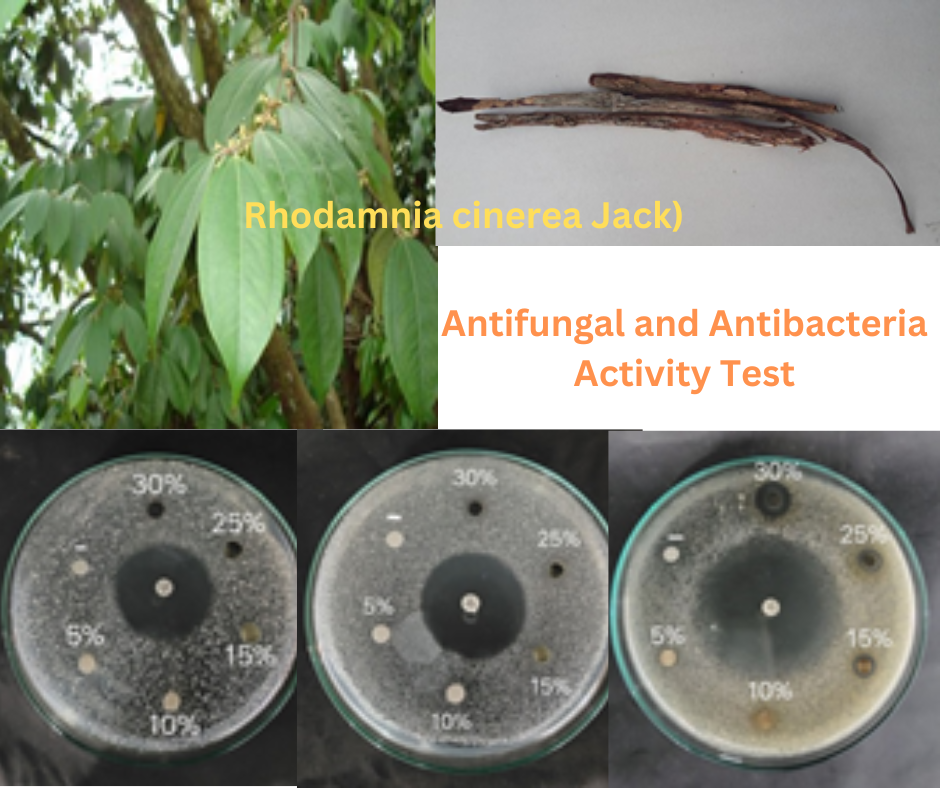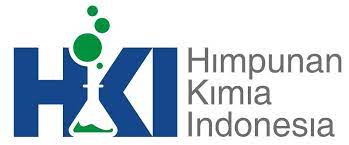
Antimicrobial of Ethanolic Extract from Marpuyan Stem Bark (Rhodamnia cinerea Jack)
Authors
Musyirna Rahmah Nasution , Ardhia Regita Cahyani , Alya Aqilla , Valentina Fitri , Leni TrianiDOI:
10.29303/aca.v7i1.193Published:
2024-04-19Issue:
Vol. 7 No. 1 (2024)Keywords:
antimicrobial, ethanol extract, Marpuyan, Stem bark.Articles
Downloads
How to Cite
Downloads
Metrics
Abstract
The Bark of Marpuyan Tree (Rhodamnia cinerea Jack) is a plant that has been empirically used by communities in Indonesia for the treatment of infectious diseases caused by bacteria and fungi. The bark of Marpuyan contains flavonoids, phenolics, and saponins. This study aimed to evaluate the antibacterial and antifungal activities of the ethanol extract of the bark of Marpuyan using the disc diffusion method at various extract concentrations, namely 30%, 25%, 15%, 10%, and 5%. The results of the antibacterial activity test against Gram-positive bacteria (Staphylococcus aureus, Staphylococcus epidermidis, and Bacillus subtilis) showed inhibitory zones with respective diameters of 11.67±0.21 mm, 12.29±0.43 mm, and 12.78±0.14 mm. These results indicate weak antibacterial activity. In the antibacterial activity test against Gram-negative bacteria (Escherichia coli, Pseudomonas aeruginosa, and Salmonella typhi), inhibitory zones were found with respective diameters of 13.05±0.05 mm, 12.58±1.78 mm, and 10.98±0.21 mm. These results also indicate weak antibacterial activity. However, in the antifungal activity test, no activity was found against Candida albicans and Malassezia furfur. Nevertheless, the ethanol extract of Marpuyan bark showed moderate antifungal activity against Trichophyton mentagrophytes, with an inhibitory zone diameter of 15.44±2.02 mm.
References
Morse, S. S. (2001). Factors in the emergence of infectious diseases (pp. 8-26). Palgrave Macmillan UK
Pancu, D. F., Scurtu, A., Macasoi, I. G., Marti, D., Mioc, M., Soica, C., ... & Dehelean, C. (2021). Antibiotics: conventional therapy and natural compounds with antibacterial activity—a pharmaco-toxicological screening. Antibiotics, 10(4), 401.
White, T. C., Findley, K., Dawson, T. L., Scheynius, A., Boekhout, T., Cuomo, C. A., ... & Saunders, C. W. (2014). Fungi on the skin: dermatophytes and Malassezia. Cold spring harbor perspectives in medicine, 4(8), a019802.
Oktavia, D., Pratiwi, S. D., Munawaroh, S., Hikmat, A., & Hilwan, I. (2022). The potential of medicinal plants from heath forest: Local knowledge from Kelubi Village, Belitung Island, Indonesia. Biodiversitas Journal of Biological Diversity, 23(7).
Qamariah, N., Mulia, D. S., & Fakhrizal, D. (2020). Indigenous Knowledge of Medicinal Plants by Dayak Community in Mandomai Village, Central Kalimantan, Indonesia. Pharmacognosy Journal, 12(2).
Lakornwong, W., Kanokmedhakul, K., & Kanokmedhakul, S. (2018). A new coruleoellagic acid derivative from stems of Rhodamnia dumetorum. Natural product research, 32(14), 1653-1659.
Aminah, S., Helmi, H., dan Susanti, I. 2015. Aktivitas Antibakteri Ekstrak Kasar Aseton Daun Merapin (Rhodamnia cinerea Jack) Terhadap Bakteri Enteropatogen. Ekotonia. 1(1):46–55.
Wiart, C., Mogana, S., Khalifah, S., Mahan, M., Ismail, S., Buckle, M., ... & Sulaiman, M. (2004). Antimicrobial screening of plants used for traditional medicine in the state of Perak, Peninsular Malaysia. Fitoterapia, 75(1), 68-73
Nasution, R.M., Sari, P.R.A., Utami, P.I., dan Halianti, T. 2019. Penentuan Aktivitas Tabir Surya Ekstrak Etanol Daun Marpuyan (Rhodamnia cinerea Jack) Secara In Vitro. Jurnal Dunia Farmasi. 4(2): 59-67.
Sopianti D.S., 2020, Identifikasi Senyawa Flavonoid Dari Ekstrak Daun Merampuyan (Rhodamnia Cinerea Jack) Dengan Metode Klt, Jurnal Ilmiah Pharmacy,7(1)
Brophy, J. J., Goldsack, R. J., & Forster, P. I. (1997). The leaf essential oils of the Australian species of Rhodamnia (Myrtaceae). Flavour and fragrance journal, 12(5), 345-354.
Borges, C. V., Minatel, I. O., Gomez-Gomez, H. A., & Lima, G. P. P. (2017). Medicinal plants: Influence of environmental factors on the content of secondary metabolites. Medicinal plants and environmental challenges, 259-277.
Radušienė, J., Karpavičienė, B., & Stanius, Ž. (2012). Effect of external and internal factors on secondary metabolites accumulation in St. John’s worth. Botanica Lithuanica, 18(2), 101-108.
Rindita, R., Rahmaesa, E., Devi, R. K., & Alawiyah, L. F. (2020). Exploration, phenolic content determination, and antioxidant activity of dominant pteridophytes in Gunung Malang Village, Mount Halimun Salak National Park, Indonesia. Biodiversitas Journal of Biological Diversity, 21(8).
Kirby, B. (2009). Kirby-Bauer disk diffusion susceptibility test protocol. American Society for Microbiology, 66, 208.
Bertrand, R. L. (2019). Lag phase is a dynamic, organized, adaptive, and evolvable period that prepares bacteria for cell division. Journal of bacteriology, 201(7), e00697-18.
Aryal, S. (2019). Potato Dextrose Agar (PDA)-Principle, Uses, Procedure & Characteristics. Microbiology Info. com [Internet], 15.
Ningsih, W., & Arel, A. (2021). Clove Oil (Syzygium aromaticum) Edible Film Formulation and Antibacterial Activity Test against Streptococcus mutans. Journal of Fundamental and Applied Pharmaceutical Science, 2(1), 1-9.
Puspadewi, R., Gumilar, A., & Kartikasari, T. D. (2022, November). The Ability of Lactobacillus Plantarum to Produce Exopolysaccharides with Additional Nutrients. In IOP Conference Series: Earth and Environmental Science (Vol. 1104, No. 1, p. 012011). IOP Publishing.
Bubonja-Šonje, M., Knežević, S., & Abram, M. (2020). Challenges to antimicrobial susceptibility testing of plantderived polyphenolic compounds. Arhiv za higijenu rada i toksikologiju, 71(4), 300-311.
Kassim, A., Omuse, G., Premji, Z., & Revathi, G. (2016). Comparison of Clinical Laboratory Standards Institute and European Committee on Antimicrobial Susceptibility Testing guidelines for the interpretation of antibiotic susceptibility at a University teaching hospital in Nairobi, Kenya: a cross-sectional study. Annals of clinical microbiology and antimicrobials, 15, 1-7.
Malanovic, N., & Lohner, K. (2016). Gram-positive bacterial cell envelopes: The impact on the activity of antimicrobial peptides. Biochimica et Biophysica Acta (BBA)-Biomembranes, 1858(5), 936-946.
Weir, E., Lawlor, A., Whelan, A., & Regan, F. (2008). The use of nanoparticles in anti-microbial materials and their characterization. Analyst, 133(7), 835-845.
Epand, R. M., Walker, C., Epand, R. F., & Magarvey, N. A. (2016). Molecular mechanisms of membrane targeting antibiotics. Biochimica et Biophysica Acta (BBA)-Biomembranes, 1858(5), 980-987.
Horne, J. E., Brockwell, D. J., & Radford, S. E. (2020). Role of the lipid bilayer in outer membrane protein folding in Gram-negative bacteria. Journal of Biological Chemistry, 295(30), 10340-10367.
El-Shemy, H. (Ed.). (2017). Active Ingredients from Aromatic and Medicinal Plants. BoD–Books on Demand.
Debalke, D., Birhan, M., Kinubeh, A., & Yayeh, M. (2018). Assessments of antibacterial effects of aqueous-ethanolic extracts of Sida rhombifolia’s aerial part. The Scientific World Journal, 2018.
Tagousop, C. N., Tamokou, J. D. D., Kengne, I. C., Ngnokam, D., & Voutquenne-Nazabadioko, L. (2018). Antimicrobial activities of saponins from Melanthera elliptica and their synergistic effects with antibiotics against pathogenic phenotypes. Chemistry Central Journal, 12(1), 1-9.
Ernilasari, E., Walil, K., Fitmawati, F., Roslim, D. I., Zumaidar, Z., Saudah, S., & Rayhannisa, R. (2021). Antibacterial activity of leaves, flowers, and fruits extract of Etlingera elatior from Nagan Raya District, Indonesia against Escherichia coli and Staphylococcus aureus. Biodiversitas Journal of Biological Diversity, 22(10).
License
Copyright (c) 2024 Musyirna Rahmah Nasution, Ardhia Regita Cahyani, Alya Aqilla, Valentina Fitri, Leni Triani

This work is licensed under a Creative Commons Attribution-NonCommercial-ShareAlike 4.0 International License.
Authors who publish with ACA: Acta Chimica Asiana agree to the following terms:
- Authors retain copyright and grant the journal right of first publication with the work simultaneously licensed under a Creative Commons Attribution-NonCommercial-ShareAlike 4.0 International License. This license allows authors to use all articles, data sets, graphics, and appendices in data mining applications, search engines, web sites, blogs, and other platforms by providing an appropriate reference. The journal allows the author(s) to hold the copyright without restrictions and will retain publishing rights without restrictions.
- Authors are able to enter into separate, additional contractual arrangements for the non-exclusive distribution of the journal's published version of the work (e.g., post it to an institutional repository or publish it in a book), with an acknowledgement of its initial publication in ACA: Acta Chimica Asiana.
- Authors are permitted and encouraged to post their work online (e.g., in institutional repositories or on their website) prior to and during the submission process, as it can lead to productive exchanges, as well as earlier and greater citation of published work (See The Effect of Open Access).





 Indonesian Chemical Society, Chapter Nusa Tenggara. Jalan Majapahit 62 Mataram, University of Mataram, 83125, Indonesia
Indonesian Chemical Society, Chapter Nusa Tenggara. Jalan Majapahit 62 Mataram, University of Mataram, 83125, Indonesia





